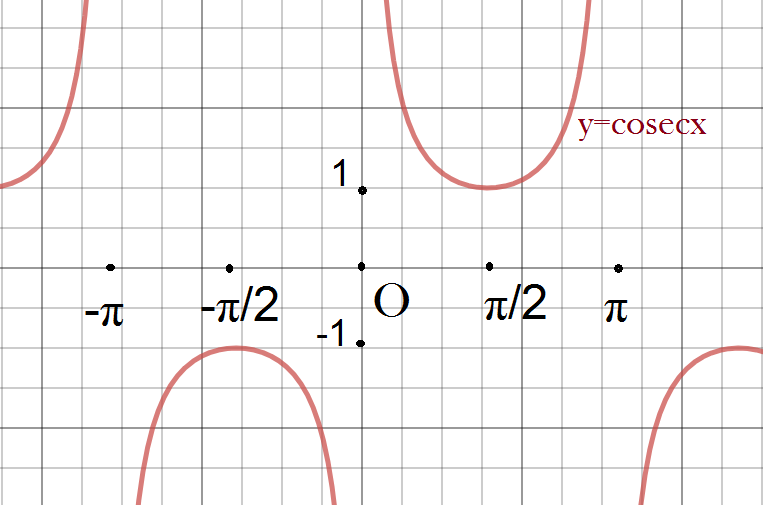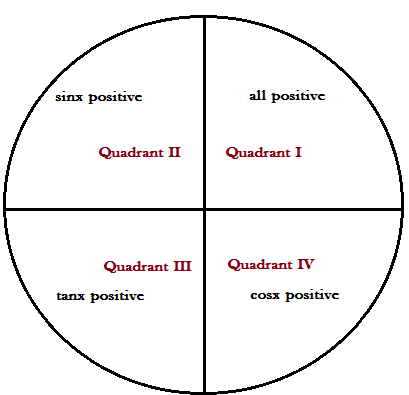
Find the value of $\operatorname{cosec} ( - {1410^ \circ })$
Answer
576.3k+ views
Hint: We know that \[{\text{cosec}}\left( { - \theta } \right) = - {\text{cosec}}\theta \]
Again, the function \[y = \cos ecx\] has a period of \[2\pi \] or \[360^\circ \], i.e. the value of \[\cos ecx\;\] repeats after an interval of \[2\pi \] or \[360^\circ \].
Therefore write \[1410^\circ \] as \[(4 \times 2\pi - 30^\circ )\] and proceed.
Complete step-by-step answer:
We know that the function \[y = \cos ecx\] has a period of \[2\pi \] or \[360^\circ \], i.e. the value of \[\cos ecx\;\] repeats after an interval of \[2\pi \] or \[360^\circ \].

Therefore,
\[\operatorname{cosec} ( - {1410^ \circ })\]
Using, \[\left[ {{\text{cosec}}\left( { - \theta } \right) = - {\text{cosec}}\theta } \right]\], we get,
\[ = - \operatorname{cosec} ({1410^ \circ }){\text{ }}\]
We can write the above statement as,
\[ = - \operatorname{cosec} \left( {(4 \times {{360}^ \circ }) - {{30}^ \circ }} \right)\]
Since \[{\text{141}}{0^ \circ }\] lies in the fourth quadrant, therefore is \[{\text{cosec141}}{0^ \circ }\] negative
\[ = - \left( { - \operatorname{cosec} {{30}^ \circ }} \right){\text{ }}\]
\[ = \operatorname{cosec} {30^ \circ }\]
As, \[\operatorname{cosec} ({30^ \circ }) = 2\], we get,
\[ = 2\]
Hence, the value of $\operatorname{cosec} ( - {1410^ \circ })$ is 2.
Note: Note the following important formulae:
1.$\cos x = \dfrac{1}{{\sec x}}$ , $\sin x = \dfrac{1}{{\cos ecx}}$ , $\tan x = \dfrac{1}{{\cot x}}$
2.${\sin ^2}x + {\cos ^2}x = 1$
3.\[{\sec ^2}x - {\tan ^2}x = 1\]
4.\[{\operatorname{cosec} ^2}x - {\cot ^2}x = 1\]
5.$\sin ( - x) = - \sin x$
6.$\cos ( - x) = \cos x$
7.$\tan ( - x) = - \tan x$
8.$\sin \left( {2n\pi \pm x} \right) = \sin x{\text{ , period 2}}\pi {\text{ or 3}}{60^ \circ }$
9.$\cos \left( {2n\pi \pm x} \right) = \cos x{\text{ , period 2}}\pi {\text{ or 3}}{60^ \circ }$
10.$\tan \left( {n\pi \pm x} \right) = \tan x{\text{ , period }}\pi {\text{ or 18}}{0^ \circ }$
Sign convention:

Also, the trigonometric ratios of the standard angles are given by
Again, the function \[y = \cos ecx\] has a period of \[2\pi \] or \[360^\circ \], i.e. the value of \[\cos ecx\;\] repeats after an interval of \[2\pi \] or \[360^\circ \].
Therefore write \[1410^\circ \] as \[(4 \times 2\pi - 30^\circ )\] and proceed.
Complete step-by-step answer:
We know that the function \[y = \cos ecx\] has a period of \[2\pi \] or \[360^\circ \], i.e. the value of \[\cos ecx\;\] repeats after an interval of \[2\pi \] or \[360^\circ \].

Therefore,
\[\operatorname{cosec} ( - {1410^ \circ })\]
Using, \[\left[ {{\text{cosec}}\left( { - \theta } \right) = - {\text{cosec}}\theta } \right]\], we get,
\[ = - \operatorname{cosec} ({1410^ \circ }){\text{ }}\]
We can write the above statement as,
\[ = - \operatorname{cosec} \left( {(4 \times {{360}^ \circ }) - {{30}^ \circ }} \right)\]
Since \[{\text{141}}{0^ \circ }\] lies in the fourth quadrant, therefore is \[{\text{cosec141}}{0^ \circ }\] negative
\[ = - \left( { - \operatorname{cosec} {{30}^ \circ }} \right){\text{ }}\]
\[ = \operatorname{cosec} {30^ \circ }\]
As, \[\operatorname{cosec} ({30^ \circ }) = 2\], we get,
\[ = 2\]
Hence, the value of $\operatorname{cosec} ( - {1410^ \circ })$ is 2.
Note: Note the following important formulae:
1.$\cos x = \dfrac{1}{{\sec x}}$ , $\sin x = \dfrac{1}{{\cos ecx}}$ , $\tan x = \dfrac{1}{{\cot x}}$
2.${\sin ^2}x + {\cos ^2}x = 1$
3.\[{\sec ^2}x - {\tan ^2}x = 1\]
4.\[{\operatorname{cosec} ^2}x - {\cot ^2}x = 1\]
5.$\sin ( - x) = - \sin x$
6.$\cos ( - x) = \cos x$
7.$\tan ( - x) = - \tan x$
8.$\sin \left( {2n\pi \pm x} \right) = \sin x{\text{ , period 2}}\pi {\text{ or 3}}{60^ \circ }$
9.$\cos \left( {2n\pi \pm x} \right) = \cos x{\text{ , period 2}}\pi {\text{ or 3}}{60^ \circ }$
10.$\tan \left( {n\pi \pm x} \right) = \tan x{\text{ , period }}\pi {\text{ or 18}}{0^ \circ }$
Sign convention:

Also, the trigonometric ratios of the standard angles are given by
| \[0^\circ \] | \[30^\circ \] | \[45^\circ \] | \[60^\circ \] | \[90^\circ \] | |
| \[\operatorname{Sin} x\] | 0 | $\dfrac{1}{2}$ | $\dfrac{1}{{\sqrt 2 }}$ | $\dfrac{{\sqrt 3 }}{2}$ | 1 |
| \[\cos x\] | 1 | $\dfrac{{\sqrt 3 }}{2}$ | $\dfrac{1}{{\sqrt 2 }}$ | $\dfrac{1}{2}$ | 0 |
| \[\tan x\] | 0 | $\dfrac{1}{{\sqrt 3 }}$ | 1 | $\sqrt 3 $ | Undefined |
| \[cotx\] | undefined | $\sqrt 3 $ | 1 | $\dfrac{1}{{\sqrt 3 }}$ | 0 |
| \[\cos ecx\;\] | undefined | 2 | $\sqrt 2 $ | $\dfrac{2}{{\sqrt 3 }}$ | 1 |
| \[\operatorname{Sec} x\] | 1 | $\dfrac{2}{{\sqrt 3 }}$ | $\sqrt 2 $ | 2 | Undefined |
Recently Updated Pages
Why are manures considered better than fertilizers class 11 biology CBSE

Find the coordinates of the midpoint of the line segment class 11 maths CBSE

Distinguish between static friction limiting friction class 11 physics CBSE

The Chairman of the constituent Assembly was A Jawaharlal class 11 social science CBSE

The first National Commission on Labour NCL submitted class 11 social science CBSE

Number of all subshell of n + l 7 is A 4 B 5 C 6 D class 11 chemistry CBSE

Trending doubts
What is meant by exothermic and endothermic reactions class 11 chemistry CBSE

10 examples of friction in our daily life

One Metric ton is equal to kg A 10000 B 1000 C 100 class 11 physics CBSE

1 Quintal is equal to a 110 kg b 10 kg c 100kg d 1000 class 11 physics CBSE

Difference Between Prokaryotic Cells and Eukaryotic Cells

What are Quantum numbers Explain the quantum number class 11 chemistry CBSE




